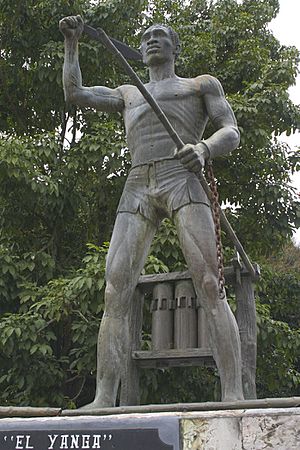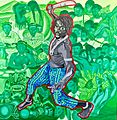Gaspar Yanga facts for kids
Quick facts for kids
Gaspar Yanga
|
|
|---|---|

Statue of Yanga in Yanga, Veracruz
|
|
| Born | 14 May 1545 |
| Died | After 1618 San Lorenzo de los Negros, New Spain
|
| Nationality | Afro-Mexican, possibly of Bran ancestry |
| Occupation | Revolutionary |
| Known for | Established and achieved self-government for a maroon colony of freed slaves |
Gaspar Yanga (born May 14, 1545 – died after 1618) was an African leader. He led a group of people who had escaped slavery, called maroons, in the mountains near Veracruz, Mexico. This was during the early days of Spanish rule in the Americas.
In 1609, he successfully fought off a Spanish attack on his community. The maroons kept raiding Spanish towns. Finally, in 1618, Yanga made a deal with the Spanish government. His community would be free to govern itself. This settlement was later named San Lorenzo de los Negros.
Later, Yanga became known as a "national hero of Mexico." He was even called "The First Liberator of America." In 1932, the town he founded in Veracruz was renamed Yanga to honor him.
Contents
Yanga's Early Life
Yanga, also known as Nyanga, was believed to be from the Bran people and a member of the royal family in Gabon. He was captured and sold into slavery in Mexico, which was then called New Spain.
Around 1570, Yanga led a group of enslaved people to escape. They went to the highlands near Veracruz. There, they built a small community called a palenque, which was a hidden settlement for maroons.
This hidden location protected them for over 30 years. Many other people who had escaped slavery found their way to Yanga's community.
The Fight for Freedom
Yanga's group survived by sometimes raiding Spanish caravans. These caravans carried goods along the main road between Veracruz and Mexico City. Because of these raids, the Spanish government decided to act in 1609. They wanted to take back control of the area.
By 1609, Yanga's group had grown to more than 500 men. Rumors spread about a possible large uprising by the maroons. They were said to be planning to kill white settlers and name a Black maroon as king.
The maroons not only raided farms for food but also attacked the important road connecting Veracruz and Mexico City. This road was vital for trade and communication in New Spain. These attacks worried the Spanish authorities.
The Spanish viceroy, Luis de Velasco, sent soldiers to stop Yanga's group. However, the maroons were good at defending themselves. Their hiding places were hard to reach, which gave them an advantage.
The Spanish suffered many losses. The attacks on the royal road also hurt the economy of the colony. It became clear that fighting the maroons was difficult and costly for the Spanish.
The Spanish Attack of 1609
In January 1609, about 550 Spanish troops marched from Puebla. Around 100 were regular soldiers, and the rest were new recruits. The maroons had about 100 fighters with some firearms. Another 400 were armed with stones, machetes, and bows and arrows.
The maroon fighters were led by Francisco de la Matosa, who was from Angola. Yanga, who was quite old by this time, wanted to use his group's knowledge of the land to make the Spanish suffer enough to negotiate.
As the Spanish troops got closer, Yanga sent a captured Spaniard with an offer of peace. He asked for a treaty, similar to those made with Native American groups. This treaty would allow his community to govern itself. In return, they would pay tribute to the Spanish and help them if they were attacked.
Yanga also offered to return any enslaved people who might try to escape to his community. This was important to calm the worries of slave owners in the region.
The Spanish refused Yanga's terms and attacked. Both sides suffered heavy losses. The Spanish managed to enter and burn the maroon settlement. However, the maroons fought bravely and knew the land very well. The Spanish could not win a clear victory.
The fighting continued for years without a clear winner. Finally, the Spanish agreed to talk. Yanga's terms were accepted. It was also agreed that only Franciscan priests would serve the community. Yanga's family would also have the right to rule.
In 1618, the treaty was signed. By 1630, the town of San Lorenzo de los Negros de Cerralvo was officially established. Today, this town in Veracruz is known as Yanga.
Yanga's Legacy
In 1871, many years after Mexico became independent, Yanga was officially named a "national hero of Mexico." He was also called El Primer Libertador de las Americas (The First Liberator of the Americas).
This recognition was largely due to the work of historian Vicente Riva Palacio. He found old records about Yanga and the Spanish expedition against him. Riva Palacio published his findings, which helped make Yanga's story widely known. He described the maroons of San Lorenzo de los Negros as proud people who would not be defeated.
Images for kids
See also
 In Spanish: Gaspar Yanga para niños
In Spanish: Gaspar Yanga para niños


